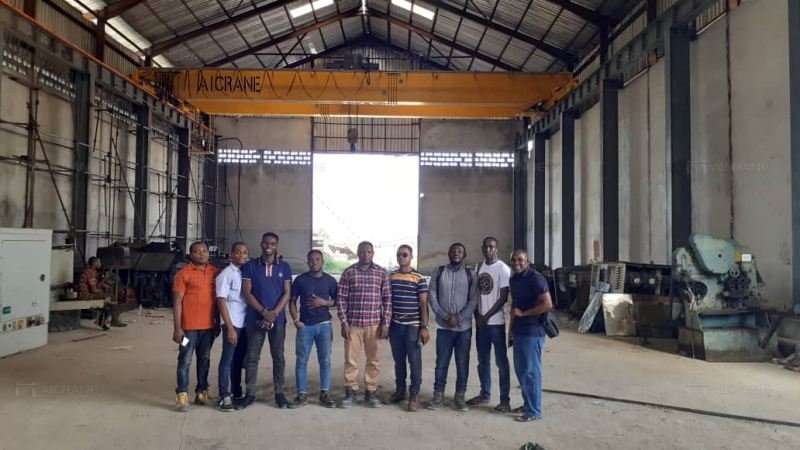Workshop overhead cranes are invaluable tools for lifting and moving heavy loads efficiently in industrial settings. They help streamline operations, boost productivity, and enhance workplace safety. However, to ensure these cranes continue to
perform optimally and safely, regular maintenance is essential. Poorly maintained cranes can lead to costly breakdowns, workplace accidents, and reduced equipment lifespan. In this article, we’ll explore key maintenance tips that can help ensure the long-term performance of your workshop overhead crane.
Establish a Regular Inspection Schedule
One of the most critical aspects of crane maintenance is establishing a routine inspection schedule. Regular inspections help detect early signs of wear and tear, preventing small issues from becoming major problems.
Key elements of routine inspections include:
- Visual Checks: Operators should visually inspect the crane before each use to check for obvious signs of damage, such as frayed cables, worn-out hooks, or bent components.
- Operational Tests: Perform routine tests of the crane’s lifting and lowering mechanisms, brakes, and control systems. Ensure that all moving parts function smoothly without unusual sounds or delays.
- Record Keeping: Keep detailed records of all inspections and maintenance activities. This helps track the crane’s performance over time and ensures that regular maintenance schedules are being followed.
Adhering to manufacturer-recommended inspection intervals, including daily, monthly, and annual checks, can help prolong the life of your crane.
Lubricate Moving Parts
Overhead cranes have numerous moving parts, such as gears, hoists, trolleys, and pulleys, which are subject to friction during operation. Proper lubrication of these components is essential to ensure smooth operation and to minimize wear and tear.
Lubrication tips:
- Use the Right Lubricant: Always use the manufacturer-recommended lubricants for your crane. Incorrect lubricants can damage mechanical components and lead to premature failure.
- Follow a Schedule: Lubricate all moving parts regularly, particularly in high-use areas such as hoists, bridge wheels, and gearboxes.
- Check for Leaks: Inspect the crane’s hydraulic and lubrication systems for any leaks. Leaking fluids can reduce the efficiency of the lubrication process and may signal potential mechanical issues.
Regular lubrication ensures that moving parts operate smoothly, reducing mechanical stress and extending the crane’s lifespan.
Check and Replace Worn-Out Parts
Over time, various components of a workshop overhead crane will experience wear and tear. Ignoring worn-out parts can lead to catastrophic failures or accidents. Proactively replacing damaged or worn components is essential to maintaining crane safety and performance.
Common parts to monitor:
- Hoist Ropes and Chains: Regularly inspect hoist ropes and chains for signs of wear, such as fraying, kinks, or corrosion. Replace them if any signs of deterioration are detected, as these components are critical for safe lifting.
- Hooks and Latches: Examine the crane’s hooks and safety latches for cracks, deformation, or wear. Hooks should also be checked for throat opening distortion. If a hook’s throat opening has widened beyond its limits, it must be replaced immediately.
- Brakes: Cranes rely heavily on their braking systems to control lifting and lowering operations. Inspect brake pads, linings, and systems regularly to ensure they are functioning correctly. Worn-out brakes can result in dangerous load drops.
Replacing worn components on time helps avoid sudden breakdowns and ensures the crane can handle loads safely. To know more information about overhead cranes, you can open this page for details now: https://aicranemachine.com/overhead-crane/.
Ensure Proper Alignment
Proper alignment of the crane's bridge, trolleys, and runway system is essential for smooth operation. Misalignment can cause the crane to run unevenly, resulting in premature wear on parts and even accidents due to load imbalance.
Signs of misalignment:
- Unusual Noises: Grinding, squeaking, or other unusual noises during crane operation may indicate misalignment.
- Uneven Wear: Check for uneven wear on the crane’s wheels, rails, or hoist components.
- Load Drift: If loads sway excessively or drift to one side during lifting or lowering, this could be a sign of misalignment.
Scheduling periodic alignment checks helps prevent damage and improves overall crane efficiency.
Test Safety Devices Regularly
Workshop overhead cranes are equipped with safety devices, such as overload limiters, emergency stop buttons, and anti-sway systems, that are designed to prevent accidents. These devices must be tested regularly to ensure they function properly during operation.
Critical safety checks:
- Overload Protection: Test the crane’s overload limiter to verify that it will stop operations if the crane is overloaded.
- Emergency Stops: Check emergency stop buttons and switches to ensure they are easily accessible and functional. These should halt all crane movements immediately when activated.
- Anti-Sway Systems: If your crane is equipped with anti-sway technology, test it regularly to make sure loads remain stable during movement.
Regularly testing safety devices minimizes the risk of accidents and ensures compliance with safety regulations.
Train Operators on Maintenance Best Practices
Operators play a crucial role in crane maintenance. Ensuring they are trained on basic maintenance tasks and best practices can prevent unnecessary wear and tear on the crane. Operators should be familiar with daily visual checks, lubrication points, and reporting any issues immediately.
Schedule Professional Maintenance Services
While daily and monthly inspections and maintenance tasks can be performed in-house, it’s essential to schedule professional maintenance services for more in-depth inspections and repairs. Certified technicians can assess the crane’s mechanical and electrical systems and provide expert guidance on replacement parts, upgrades, and repairs.
Maintaining a workshop overhead crane is essential for ensuring long-term performance, operational safety, and cost efficiency. By adhering to a regular maintenance schedule, lubricating moving parts, replacing worn-out components, checking alignment, and testing safety devices, you can extend the life of your crane and reduce the likelihood of accidents. Investing in professional maintenance services and proper operator training further ensures that your workshop overhead crane will continue to operate safely and efficiently for years to come.
